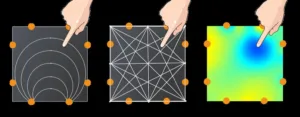One of the big advantages of touch screens is that their use is intuitive. The implementation of touch screen technology does, however, have several practical disadvantages including the fact that current touch screen technologies are most easily and successfully implemented on product surfaces that are physically small, rigid and flat.

The difficulty with large surfaces is that the cost of touch screens increase faster than their area. The result is that a touch screen can become prohibitively expensive in applications that are physically large. There are also problems in applying a touch screen to a surface that is either flexible or that has an irregular shape. Given these constraints, the sweet spot for the application of touch screens includes electronic devices such as smartphones, tablets and kiosks. To effectively implement touch screens in products and applications outside of the sweet spot, improvements are needed in touch technology.
To address these issues, a team of researchers at the Human-Computer Interaction Institute within Carnegie Mellon University (Pittsburgh, PA) is developing a low cost touch sensing technology with the specific goal of broadening the range of objects and products that can potentially be enabled with touch screens.
The new technology is named Electrick. It is based on using electric field tomography in concert with an electrically conductive surface. A recent article by the team is entitled “Electrick: Low-Cost Touch Sensing Using Electric Field Tomography.” It was presented at CHI 2017 which was held between May 6 and 11 in Denver, CO. The article is available on-line and can be found here.
To enable Electrick, objects must either be made from an electrically conductive material or to have been coated with a material that is electrically conductive. The means used to track the location of a user’s finger within an interactive area is based on the use of the so-called shunting effect. The shunting effect uses the phenomenon that, when a human body is proximate to an electric field, a small amount of current is drawn to the ground.
To implement the Electrick approach, a series of electrodes is attached around the edges of a conductive substrate that defines the interactive area. An electronic circuit is attached to these electrodes. One pair of the electrodes is used to inject current into the substrate which, in turn, establishes an electric field pattern within the interactive area. The other pairs of electrodes in the series measure voltage which, in turn, is used to determine changes in the distribution of the electric field caused by the touch of the user’s finger. This is illustrated in the figure below.
Left: Current is inserted by one pair of electrodes and the voltage measured by the other pairs. Center: A mesh of cross sectional measurements. Right: A reconstructed 2D touch sensing image. Blue indicates areas of low current density.
The electrode pairs used to inject the current and detect the voltage can be systematically varied around the interactive area. Based on the information that these measurements provide, it is possible to calculate the position of the user’s finger. A video discussing Electrick technology is appended to the end of this article.
The team reports that the Electrick technique is compatible with a many common manufacturing methods such as CNC milling, spray coating, brush coating, vacuum forming, stamping, casting and molding. The technique is also compatible with additive methods such as FDM 3D printing. Electrick is represented as especially well-suited to enable touch interactivity on rapidly fabricated objects, including those that are laser cut. In sum, the technique has the potential to bring touch interaction to a wide range of materials and new applications.
As reported in their article, the team conducted a series of user studies that characterized the performance of the Electrick approach. The published results show that Electrick can “accurately track both discrete and continuous touch input under various test conditions, materials, shapes and sizes. It is also robust over time and across users.” -Arthur Berman
Carnegie Mellon University, Yang Zhang, [email protected]

